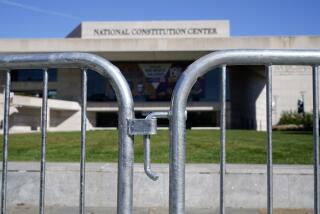U.S. Agrees to Limits on Space-Based Missile Shield : Military: The policy switch is designed to win Soviet approval of a scaled-down version of ‘Star Wars’ system.
- Share via
WASHINGTON — The United States agreed Tuesday to accept limits on space-based missile defenses in a bid to win Soviet approval of a proposed system designed to provide protection against a limited ballistic missile attack.
The change of position, adopted by U.S. arms control negotiators in Geneva, was prepared before the unexpected agreement by Soviet President Mikhail S. Gorbachev to consider amending a 1972 arms treaty whose terms until now have been considered sacrosanct by the Soviets.
Such a “negotiated solution,” the White House said in announcing the new stance, would “make the world a safer place” by allowing the United States and its allies to guard against limited ballistic missile strikes from Third World nations or from accidental launches.
Officials said the United States is seeking Soviet acceptance of a scaled-down successor to the proposed “Star Wars” antimissile program. The Bush Administration calls the revised ground- and space-based system Global Protection Against Limited Strikes.
Deployment of such a defensive system is prohibited under the 1972 Anti-Ballistic Missile Treaty. But informed sources said that a high-level U.S. delegation that briefed officials in Moscow about the U.S. proposal found the Soviets receptive to the plan.
In breaking from its previous insistence that the two sides negotiate essentially unrestrained anti-missile deployments, the Administration appears determined to ease fears that it might still pursue the “Star Wars” dream of former President Ronald Reagan.
Reagan’s original Strategic Defense Initiative envisioned the entire country sheltered by an Astrodome-like shield relying on laser-like beam weapons to intercept incoming warheads.
But the waning of the Soviet threat has further eroded congressional support for an expansive program. A senior Defense Department official said the U.S. willingness to discuss limits on the scope and timing of antimissile defenses is intended “as reassurance to the Soviets and to the Congress that we want a limited deployment.”
The smaller global protection program now planned by the Administration would begin with ground-based interceptor rockets and ultimately deploy space-based interceptors to protect against attack by up to 200 warheads. Initial stages would be deployed as early as 1996.
Officials declined to specify the nature of the limits the United States has decided to accept. But the White House statement appeared to signal that the limits would not involve any further scaling back of the global protection system, which it described as “consistent” with the limits.
In his historic address last month calling for sweeping reductions of tactical nuclear arsenals, President Bush described the antimissile defenses as central to a future in which the two superpowers for the first time could be confident of defending against accidental or unauthorized attack.
In a less predictable, post-Cold War environment, Bush said, such systems would be vital to security against attack from a third country such as Iraq.
Deployment of antimissile defenses, beyond single sites for both nations (at Grand Forks, N.D., and at Moscow), has been prohibited since the 1972 treaty; the idea of allowing such systems remains highly controversial.
Many experts believe that the prospect of a defense against nuclear attack would upset the nuclear balance. One of those critics, Jack Mendelsohn of the Arms Control Assn., warned that even a system as restricted in scope as the global protection plan would “threaten your ability to retaliate and to maintain that deterrent posture.”
But although the Soviets for decades have embraced that position, Gorbachev startled U.S. experts two weeks ago in responding to the Bush speech by declaring that he would be willing to discuss deployment of a new anti-ballistic missile defense.
Whether that statement represented a true change of position or was meant merely to show cooperation remains a subject of some dispute, and U.S. officials were unwilling Tuesday to predict whether the new proposal would win Soviet approval.
“It’s a way to test whether they were serious,” an Administration official said. But a senior Defense Department official said the Pentagon regards the apparent Gorbachev reversal as a “very significant change” and described the U.S. proposal as a “fairly big deal.”
The global protection system proposed by the Administration would use detection systems aboard satellites to pick up evidence of a missile attack and seek to destroy incoming warheads with ground-based interceptors. The $32-billion Administration plan calls for construction of five or more ground sites and would eventually include space-based interceptors.
But the plan has won only mixed support from Congress, with the Senate embracing a more limited plan that would exclude space-based interceptors. The House has approved funding only for research on grounds that deployment would violate the Anti-Ballistic Missile Treaty.
The Administration requested $4.6 billion for the overall “Star Wars” program for the year that began Oct. 1. The Senate approved $4 billion, and the House $2.66 billion.
The two versions are to be reconciled in conference this week. In announcing the change in the U.S. stance in Geneva by the Defense and Space Negotiating Group, the White House appealed to Congress to approve the Senate version of the plan.
Times staff writers John M. Broder and Robert C. Toth contributed to this report.
More to Read
Sign up for Essential California
The most important California stories and recommendations in your inbox every morning.
You may occasionally receive promotional content from the Los Angeles Times.










